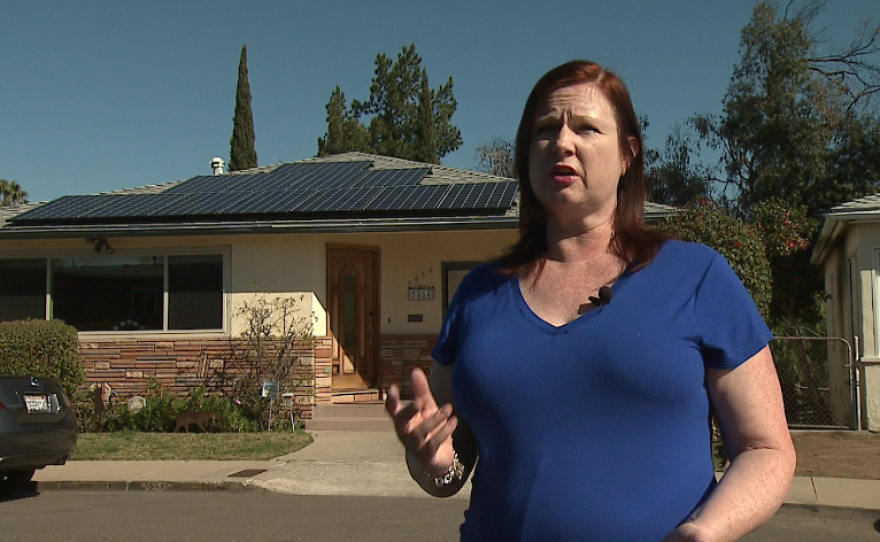San Diego resident Finella Arnold shows off an image on her laptop. It’s a diagram of the 18 solar panels on the roof of her house. It shows how well the panels are performing as they convert sunlight into energy for her home. Arnold said she’s totally into it.
“I geek out on the monitoring of it. I can see it on my phone if I want to. But I can also look on the computer. I can watch as a cloud passes by. I can watch the energy production go down,” she said.
Arnold’s solar array cost $16,800, minus a 30 percent federal tax credit.
The array is also very visible from the front of her house. The panels are perched along the roof above her front door.
Is this what a Realtor would call curb appeal?
“I love it. To me — and I think this with everybody’s solar panels — it looks smart. When I drive by and I see solar systems I think, 'These are smart people,'” Arnold said.
The San Diego neighborhood she lives in is El Cerrito. To say that solar energy has taken off here is an understatement. You see them on front roofs as you walk the dog. You catch glimpses of them on the back roofs of houses. The same could be said of much of San Diego.
Tax credits and subsidized manufacturing of solar panels in China have made solar much more affordable.
Robert Gill is another El Cerrito resident for whom solar made financial sense.
Look at his electric meter around the noon hour and you see a left-pointing arrow that shows the meter spinning backwards. This means he’s receiving energy credits from the power company.
But there’s one place Gill doesn’t have solar panels: the sunny south-facing front of the house, which faces the street. He didn’t think that would look very smart.
“We didn’t want to mess with the character of the house and have panels put on the south-facing side. So all of our panels are on the back,” he said.
Gill is really into his house. He knows its history. He knows who built it. And it wasn’t built to have glass panels in front.
The aesthetic effect of solar energy is one potential downside to retrofitting a home with an energy source that seems very green and, nowadays, cost effective. You also have to consider the weight of those panels on a house and the reduction in their energy output over time.
There are some buildings with solar power that have not been retrofitted. The restaurant Coasterra on San Diego Bay was built for solar energy from the beginning. It’s a building that’s caught the eye of Don Mirkovitch, a professor at the San Diego NewSchool of Architecture & Design.
“A fairly good example is with Coasterra because they’re starting to look at the integration of the solar array. In this particular case it’s being used as a canopy,” he said.
The canopy looks like a black roof over the outdoor dining area, keeping the sun and rain off the patrons. If you look closely, you’ll see the solar cells embedded in it. Restaurant managers said it provides more than a third of the restaurant’s energy needs.

Two of Mirkovitch’s students have designed homes with solar energy in mind.
One model, done by third-year student Ricardo Uribe, serves as the roof of a carport. Uribe said solar panels are not what he considers to be attractive.
“It can be but most of the time it’s not. Mainly because it’s an added feature that they just throw on at the end. They don’t try to integrate. That’s why I integrated mine into my carport so it flows with the building,” Uribe said.
The push for clean energy comes down to the challenge of stopping climate change. The city of San Diego has responded by passing a climate action plan that requires 100 percent clean energy by 2035. Nicole Capretz, co-author of the city’s climate action plan, said solar will have to be a big part of that.
“What we would like to see is rooftop solar and parking lot solar on city buildings, on schools, over parking lots, on commercial buildings and private homes,” Capretz said. “What we want to see is that there will be very few places in the city you would go, turn your head, and not see solar panels.”

What Ricardo Uribe would rather see is not panels but buildings that were made for solar — solar film embedded in windows, solar power in the walls or the roofs.
“Yeah. Well I guess we’re the future architects," Uribe said. "So from now on we’re the ones who have to step up and change the rest of the game of how we design buildings.”






